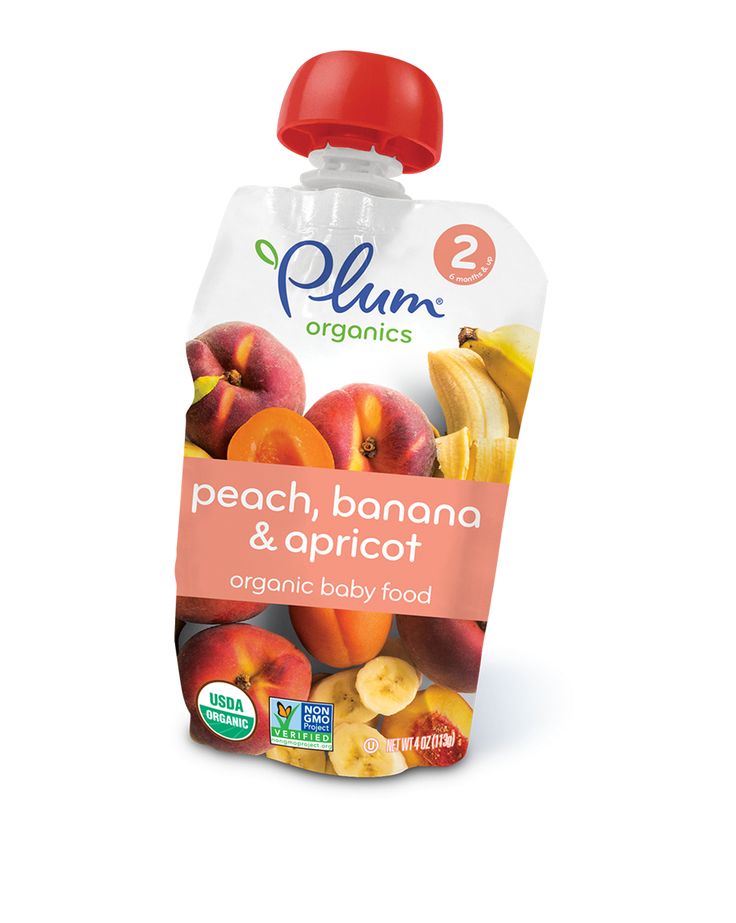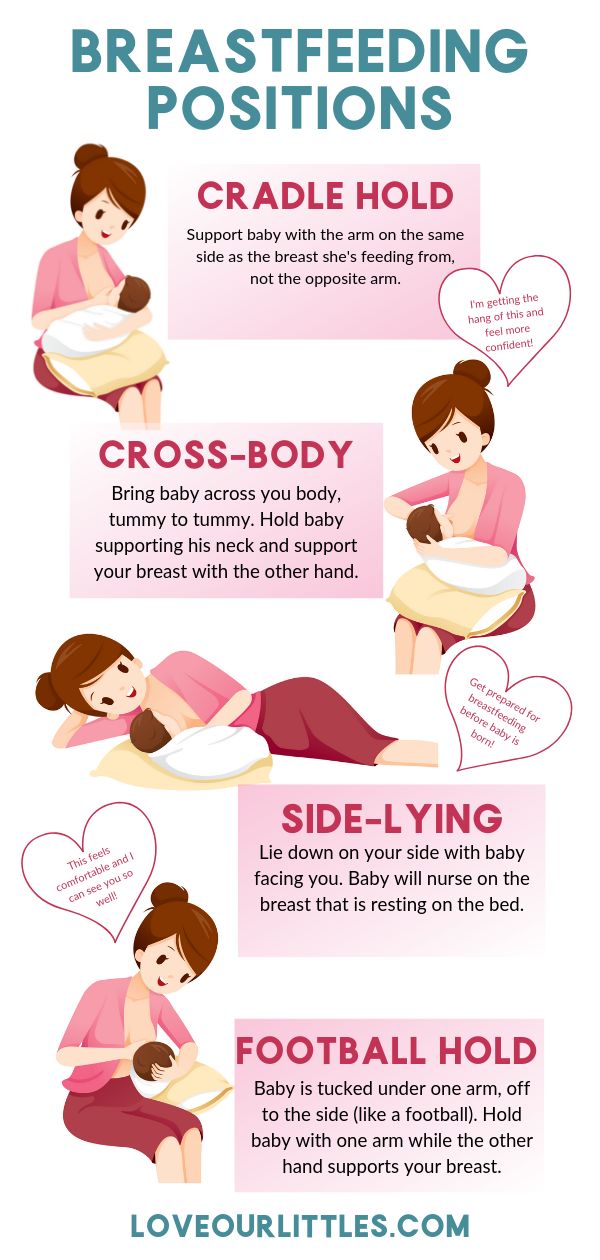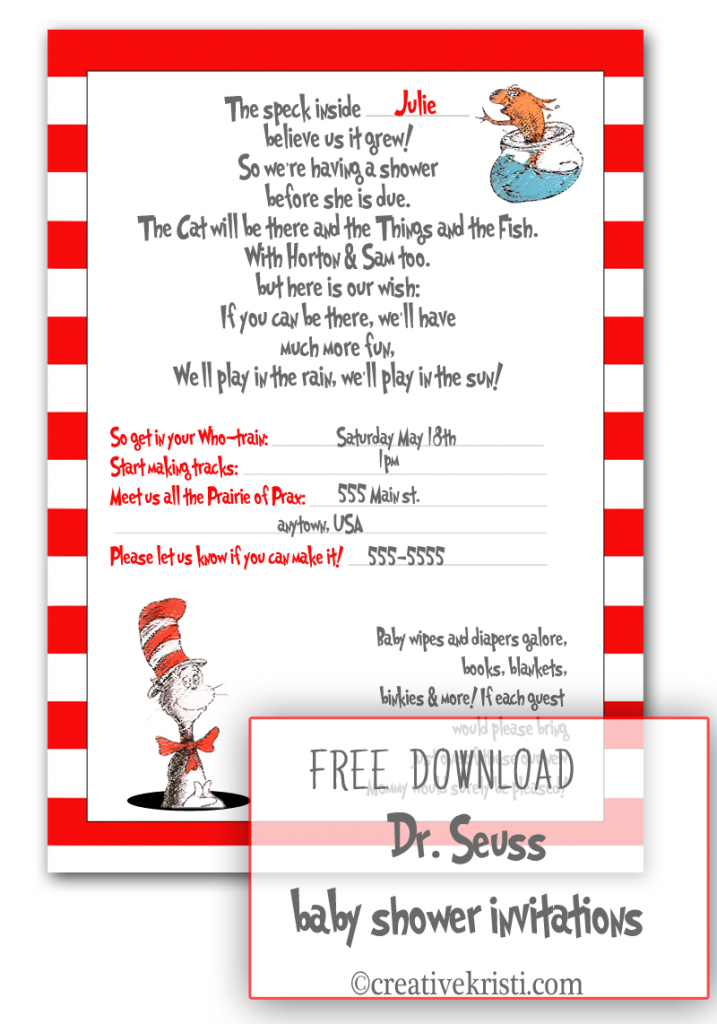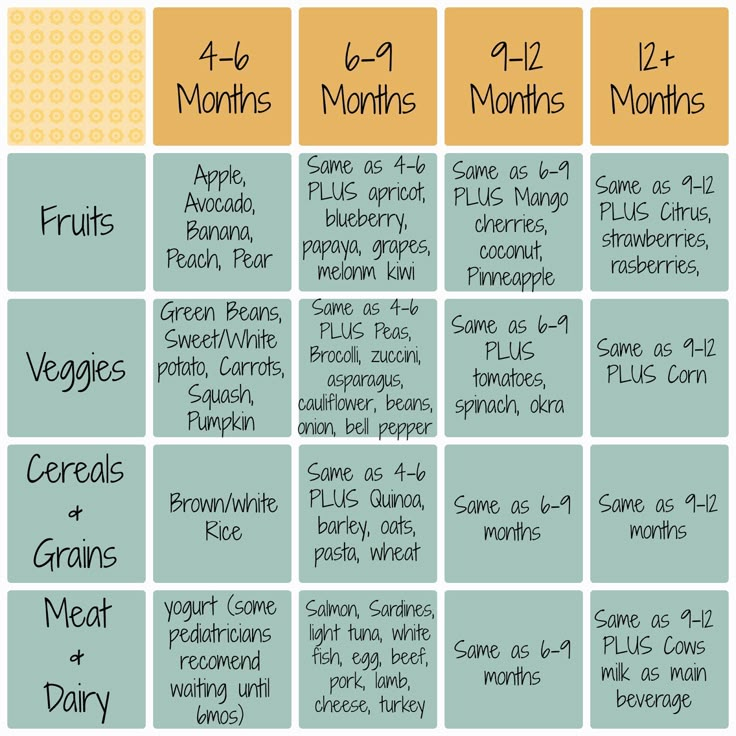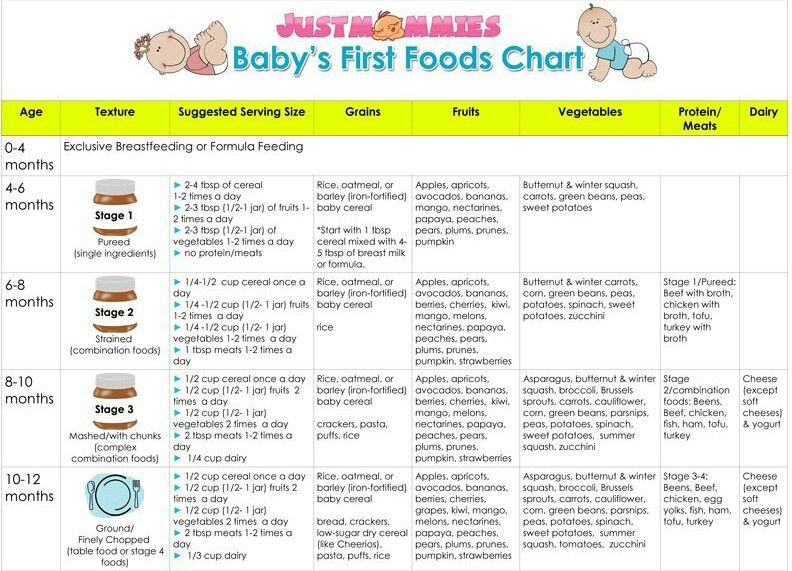Baby food pouches age
Must-Know Pros & Cons of Using Baby Food Pouches
As a parent, you have to weigh out baby food pouches vs. jars when it’s time to feed your baby or toddler, but there’s some pros and cons to both that you’ve got to be aware of first!
Her text read: Is it okay for Marin to eat baby food pouches? She eats them a lot!
My dear friend was asking about her 8 month old, first-born daughter. I smiled to myself as I typed in my answer, because there was a lot I had to say as a feeding therapist about the popular and uber convenient baby food pouches that are now a way of life for most parents of young kiddos.
But, the answer to my friend’s question wasn’t a quick reply, in fact, I told her we’d talk about it in a few days when I saw her, because there’s some dangerous pitfalls to using baby food pouches all the time.
And yet, they have some benefits over jarred baby food, besides the obvious less-mess factor, which I don’t count (more on that in a minute).
So, let me give you my list of pros and cons of baby food pouches, and at the end, I’ll reveal the baby food vehicle that’s the ultimate winner in this show down of pouches vs. jarred food!
Affiliate links used below. See our full disclosure.
Are We on the Same Page About Baby Food Pouches?
Just to be 100% clear, a baby food pouch is a bag, instead of a jar, that has a straw like spout on the top. They were first introduced in 2008 by Plum Organics, and were a massive success because they were portable and easy to dispense baby food out of. I’m not sure if the company intended babies to suck straight out of the pouches or not, but that is how many babies and toddlers eat them.
This is an example of one, and you can find them everywhere from Amazon to gas stations.
These pouches are also popular in the picky eater crowd! It’s common for toddlers to get stuck on these foods and not give them up. Parents continue to give the pouches even at older ages because it may be the only type of food their child eats, or the only fruits and vegetables in their diet.
Parents continue to give the pouches even at older ages because it may be the only type of food their child eats, or the only fruits and vegetables in their diet.
Of course, it didn’t take long for every other baby food company to also begin selling baby food pouches. Today, you can even buy your own reusable pouch, like this one, which is perfect for parents that want to make homemade baby food and kids that are hooked on pouches.
The Pros of Baby Food Pouches vs. Jars
The baby food pouch offers several winning factors over traditional jarred baby food.
# 1: Sucking thick baby food through a little straw develops stronger muscles in and around the mouth that are needed for eating! Most of us take for granted the complicated coordination and strength that eating requires. But eating is a skill too, and sucking from a straw, which doctors don’t expect babies to do until at least 9 months old, is something that can improve how a child eats.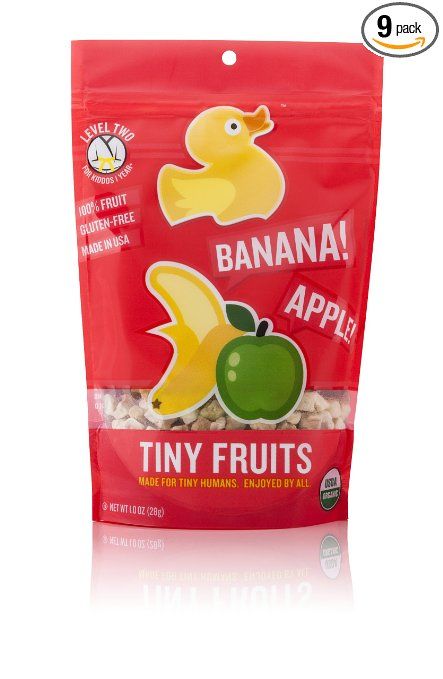
These skills are also known as oral motor skills.
# 2: They encourage independence, another skill that occupational therapists like myself, focus on. With a pouch, a baby can feed themself at a very early age, sometimes as early as 6 months. That sense of independence may help them make other independent decisions with food in the coming months.
It’s highly unlikely that a baby will be able to spoon feed themselves much before their first birthday, and it could take them until 18-24 months before they’re doing it well.
# 3: Baby food pouches are fun for kids, and combined with the fact that they can feed themselves, I suspect it’s why we see some kids not wanting to give them up. Recently, my 8 year old couldn’t wait to get his hands on an applesauce pouch from a friend. He sucked it down in a second and was looking for more, even though he eats applesauce just fine from a bowl.
Having a cute little pouch to slurp down quickly is way more fun.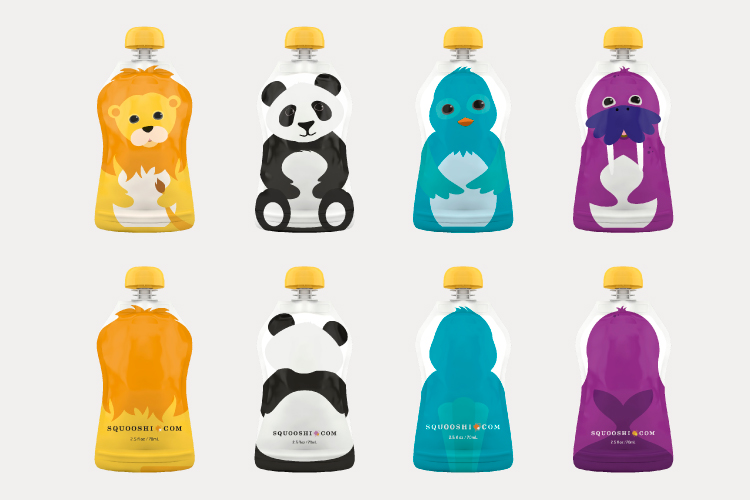
# 4: There is no denying that baby food pouches are incredibly convenient. They slide right into a purse or a diaper bag, and whether you squeeze some out onto a spoon first or just hand the whole thing to your child, the mess is much less. That can be super helpful while you’re at your 5 years old soccer game and need to squeeze a meal in for your toddler that won’t sit still!
Cons of Baby Food Pouches
There are a couple of big cons of using baby food pouches on a regular basis that I’ve seen have a negative impact on a child’s future eating. Basically, I’ve seen baby food pouches play a major role in a child developing into an extreme picky eater, or making it worse.
# 1: Baby food pouches don’t allow any mess. I know that seems great on the surface. But, babies and toddlers getting messy eating is what was meant to happen. As they touch, explore, and play in different textures of food, their brain is learning how to interpret and accept those textures. For some babies and toddlers that never touch their food or get messy, they can become extremely sensitive to new textures and that means they’ll only eat a few things.
For some babies and toddlers that never touch their food or get messy, they can become extremely sensitive to new textures and that means they’ll only eat a few things.
Think about the picky eater that only eats crunchy foods, that’s just one example.
But, many times, babies and toddlers are drawn to the pouch because they already have a sensory sensitivity, that is part of their genetic makeup. And, it’s quite common as far as feeding challenges go.
Don’t make the mistake of thinking there’s nothing that can be done about such a sensitivity though. The more a child touches any type of texture, the better their brain will adapt. When a child is only given the pouch, their brain may not have a chance to grow in that way.
# 2: Children that use baby food pouches for most or all meals may develop an aversion to a spoon coming towards their face. For some, the feeling of the metal is overwhelming and they’ll shudder and turn away. For other kids, they haven’t learned how to receive a spoon. They literally don’t know what to do. And, they could begin to resist and become fearful of the spoon.
For other kids, they haven’t learned how to receive a spoon. They literally don’t know what to do. And, they could begin to resist and become fearful of the spoon.
Obviously, this makes it difficult to teach them to eat new and different foods.
# 3: It’s easy to fall into relying on the pouches and skip offering them table foods. Some kids might not seem interested, but the pouch or even jarred baby food can give a sense of security because they’re still eating.
But, there’s a critical window of time when babies learn to chew instinctively between 8 and 11 months old. It can be taught after 11 months, but it does require some specific strategies and help to get them there. You can learn more about what to avoid when teaching your child to eat table foods in this free workshop.
# 4: Baby food pouches can get punctured inside of a bag, which can make quite a mess. Or, if a pouch does get a small hole and you don’t notice, mold could develop inside. Make sure you always do a quick inspection of the bag before feeding it to your child!
Make sure you always do a quick inspection of the bag before feeding it to your child!
The Winner of the Baby Food Pouch vs. Jar Show Down?
Drum roll please….
The winner is…
Both! I believe the best way to support your child’s feeding development, and hopefully avoid extreme picky eating, is to use a combination of both pouches and jarred or homemade baby food they’re fed from a jar.
Actually, you can use just pouches, but for at least 50% of the meals, squeeze all the food from the pouches into a bowl so your child can be fed from a spoon. Even better is using some homemade baby food, make sure it’s totally smooth without any chunks in it.
Even better still is to give your child a little bit of the baby food in their own bowl, with their own spoon (these are my favorite for babies/toddlers/preschoolers)
That way, if they dump or throw it, not a lot is wasted. With this set up, they can practice feeding themselves and are sure to get messy! If you need more convincing on embracing the mess, head to Why Babies Need to Get Messy.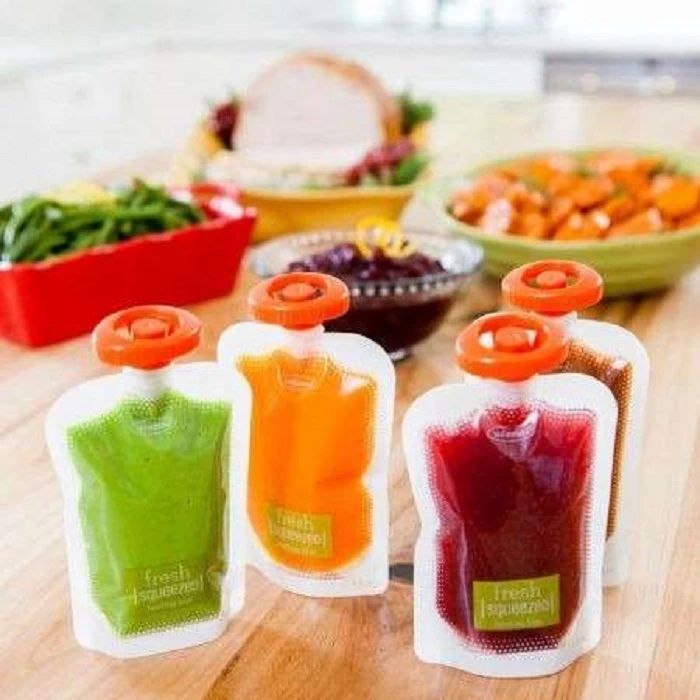
What do you think? Are you going to use pouches, jars, or both? Tell me in the comments below or pass this onto a friend that may need some guidance. It’s such a common question!
Free Printable Toddler Food Printable
Is your child getting ready for table foods? Or, maybe you’ve already started? Then click below to get my free toddler food printable list. It’s pages full of meal ideas and foods that are perfect for toddlers and older babies!
Click here for the Toddler Food Printable
More on Babies and Toddlers Eating
What to Do When Baby Won’t Eat Solids: 7 Simple Steps
Mega List of First Finger Foods
How Much Milk Should a Toddler Drink
Toddler Feeding Schedule
Alisha Grogan is a licensed occupational therapist and founder of Your Kid’s Table. She has over 14 years experience with expertise in sensory processing and feeding development in babies, toddlers, and children.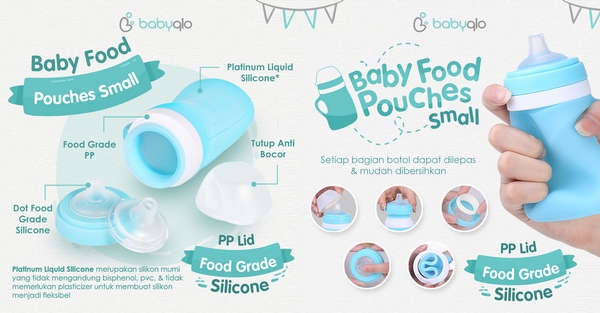 Alisha also has 3 boys of her own at home. Learn more about her here.
Alisha also has 3 boys of her own at home. Learn more about her here.
Baby Food Pouches: Pros, Cons and Advice
Should you give your child a baby food pouch?
It hasn’t taken long for baby food pouches to show up in grocery stores and superstores everywhere. You can even find them at some Starbucks!
In fact, it’s safe to say they’ve become part of the nutrition mainstream for babies and toddlers.
Baby food pouches may provide a good source of fruits and/or veggies, with many brands boasting no added sugars, juices, salt or artificial colors and use of all organic ingredients.
Some companies claim their products are cooked at lower temperatures than jarred baby food, increasing their nutrient content.
While the possibilities are endless with these convenient creations, others advise caution when using them.
In this article, you’ll learn:
- The pros and cons of using baby food pouches
- Why it’s important to connect through feeding
- 5 pointers for effective use of food pouches
Pouches are easily portable and re-sealable for handy feeding at home or on the go. They don’t get crushed like some whole fruits and vegetables or break like glass jars.
They don’t get crushed like some whole fruits and vegetables or break like glass jars.
Storage is a snap; you can refrigerate or freeze any partially used containers. They can be eaten cold, at room temperature, or heated up in warm water.
They make fruits and vegetables more accessible to toddlers when fresh options are not available or when time is limited.
It’s easy to complement your own cooked meals or restaurant fare with these blends to boost your child’s fruit and vegetable content.
Concerns about Baby Food in a PouchEven though I think they are a wonderful option overall, I do have a few concerns about how these products are used.
Like all baby food, the single-ingredient fruits or fruit and vegetable blends should be introduced around 6 months, when your baby shows developmental signs of readiness.
For infants, spoon feeding utilizes mouth muscles necessary for proper speech. Additionally, toddlers can learn how to use a spoon to build fine motor skills.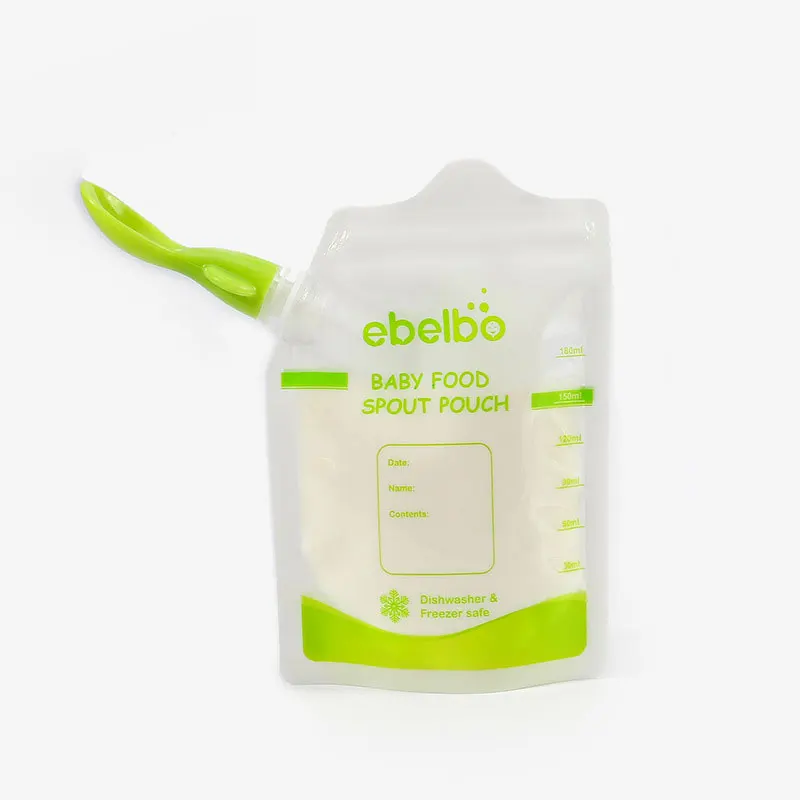
I recommend using a spoon when feeding these purees.
It is ok for toddlers to “suck” on these pouches occasionally.
However, make sure your tot has started spoon-feeding themselves, eating finger foods, and drinking from a cup with minimal spilling before giving them a pouch to “suck on.”
Don’t depend on pouches as a sole source of your child’s fruits and veggies, you want him or her to recognize and accept whole fruits and vegetables, too!
Get the Food & Nutrients for Baby’s Brain!
Keep Your Baby’s Nutrition in MindAs baby food pouches become more popular, however, parents want to make sure they fit them into the overall goals for their child’s nutritional needs and developmental progress.
Starting solids is a very important phase and there are a few overarching goals to keep in mind:
- Support your baby’s growth and development by supplying the nutrition he needs, especially for critical nutrients like iron, DHA and vitamin D.
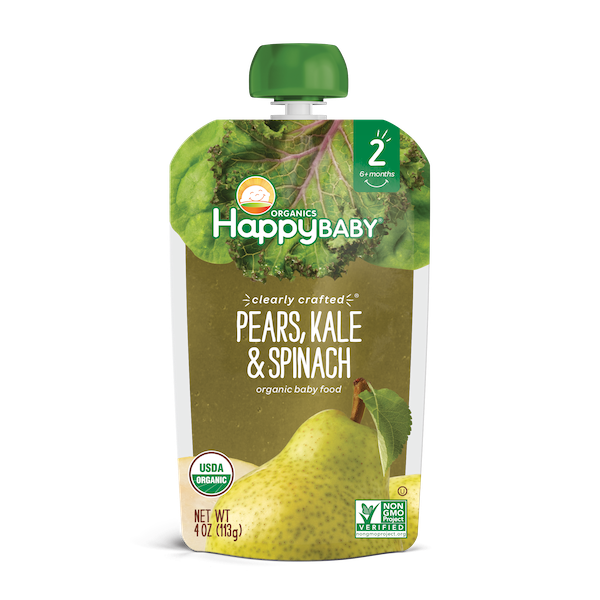
- Advance your little one along with feeding skills. By a year of age, your baby should be self-feeding with utensils (and his hands), drinking out of a cup and eating a wide variety of flavors and textures.
- Setting up healthy eating habits.
With the fast-paced world we live in, it’s easy to put feeding on the back burner and give your youngster foods they can eat without your help.
Remember, feeding is a chance to connect and enhance attachment. When your child eats in the back seat while you drive, you miss out on an opportunity to connect.
A positive feeding relationship in infancy sets the stage for future healthy eating in toddlerhood, childhood and the teen years.
5 Pointers for Appropriate Use of Baby Food PouchesI’ve got a few pointers for using baby food pouches so your baby becomes the healthy, self-feeder he was meant to be!
1. Incorporate the Spoon
Incorporate the SpoonThe original intent when baby food pouches came out on the market was to use them with a spoon.
Parents could squeeze a bit of baby food onto the spoon and feed it to their infant.
Today, the spoon is skipped and sucking from the pouch is the norm. This misses the opportunity to teach baby how to eat off a spoon and use his mouth muscles to manage, propel and chew food.
All babies need diversified texture so they learn to chew, self-feed and advance their feeding skills.
Babies who do not advance to more textured food by 9 months of age have been shown to have a greater likelihood of having feeding problems later.
Using a pouch won’t hurt your baby if you keep moving forward with feeding skills, such as introducing finger foods, offering the spoon, and encouraging self-feeding.
2. Mix in More TextureAdd textured foods such as chopped and cooked veggies, rice, noodles or shredded meats in a bowl with baby food from pouches to increase the texture experience.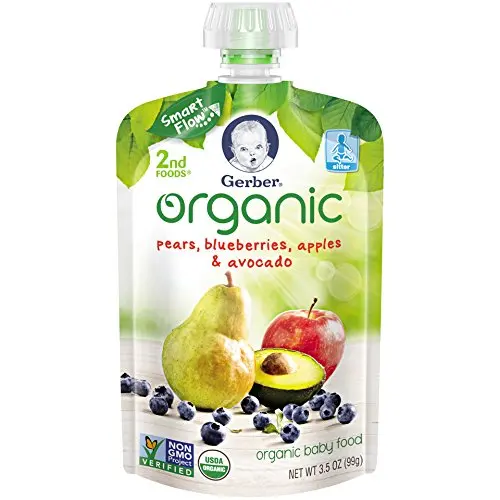
These varied textures will stimulate your baby’s sensory system and train his mouth muscles to handle a wide range of food textures.
3. Monitor Baby when Eating a Baby Food PouchNo matter what, when, or how you feed your baby, he or she needs to be monitored to watch for choking and to continue to enhance the parent-child connection and bond.
4. Start Finger Foods Between Six and Eight MonthsBetween six and eight months, babies develop their hand grasp and can hold a finger-shaped, or long, thin rectangle of soft food, such as buttered toast, soft cooked vegetables like sweet potato, or ripe fruit like banana or avocado.
By eight months, the pincer grasp emerges, and your baby can pick up small bits of food with his thumb and forefinger.
At this stage, introduce finer foods like strips and small cubes of soft food to your baby’s meal routine.
Use this opportunity to introduce singular veggies and fruits so your baby can appreciate the flavor and texture of these foods.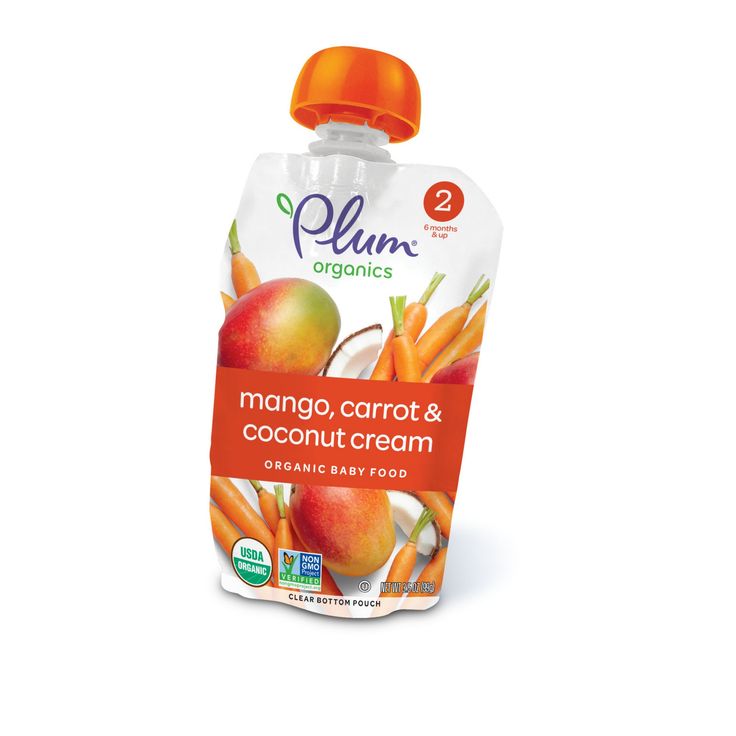
This is good advice for any child at any age (even adults), but especially for the new eater who is learning to handle food.
Sitting for meals and snacks helps children pay attention to their food and eating, learn to eat mindfully, and stop eating when full.
Your job is to provide quality nutrition and establish a good eating environment. Use developmentally appropriate feeding utensils and food textures to foster lifelong eating habits.
Need More Help with Feeding Baby?Check out our nutrition booklets, workshops, and courses and my book, The Smart Mom’s Guide to Starting Solids.
You may also enjoy reading:
- Is Rice Cereal for Babies Safe?
- Toxins in Baby Food: What You Need to Know
This article was updated on January 26, 2020.
Happy baby 15051 Baby food storage bags
Our advantages
Delivery on the day of order
Delivery works 7 days a week across the Crimea from 10:00-20:00
Wide range
children under 5 years old.
Quality Assurance
All items in my Lvenok stores carry a manufacturer's warranty. nine0004
Promotions and discounts
Be the first to know about promotions, discounts and special offers from moy Lvenok store.
Convenient self-delivery
You can pick up the order yourself in one of the stores in Simferopol.
Own warehouse
All goods are placed in moy Lvenok's warehouse equipped for storing children's goods.
Payment methods
You can pay for the purchase in any way: cash to the courier, bank card to the courier, card according to the details. nine0004
- 590 rub
In stock
531 r
VIP discount card price in retail stores
FOOD POUCH reusable baby food storage bags with lids and a spoon will help out on the road, on a walk or on a trip. They keep food fresh, are completely safe for the baby and are suitable for feeding the baby outside the home right from the bag. Screw the spoon onto the bag - no additional utensils are required. Packages are easily sealed, and a reliable zipper will not open during storage or transportation. Suitable for freezing and perfectly washed in the dishwasher. nine0004
They keep food fresh, are completely safe for the baby and are suitable for feeding the baby outside the home right from the bag. Screw the spoon onto the bag - no additional utensils are required. Packages are easily sealed, and a reliable zipper will not open during storage or transportation. Suitable for freezing and perfectly washed in the dishwasher. nine0004
COMPOSITION:
- Polyethylene terephthalate, LDPE/HDPE, polypropylene.
Reviews
Happy baby 15051 Baby food storage bags
Previous Next
Our advantages
Delivery on the day of order
Delivery works 7 days a week in the Crimea from 10:00-20:00
Wide assortment
We offer the most complete range of products for expectant mothers, newborns and children up to 5 years of age.
Quality Assurance
All items in my Lvenok stores carry a manufacturer's warranty.
Promotions and discounts
Be the first to know about promotions, discounts and special offers from moy Lvenok store.
Convenient self-delivery
You can pick up the order yourself in one of the stores in Simferopol. nine0004
Own warehouse
All goods are placed in moy Lvenok's warehouse equipped for storing children's goods.
Payment methods
You can pay for the purchase in any way: cash to the courier, bank card to the courier, card according to the details.
Products of this brand
Buy with this product
Do not forget to also buy
Baby food packaging, order packaging in Moscow at an affordable price
For manufacturers of baby food (fruit purees, nutritious cereal-milk mixtures and other products), Custom Packing offers a profitable product packaging service. We pack batches of any size in doy-packs with a convenient dosing fitting (side or central). Pouring the mixture is carried out on modern filling equipment, marking and stickering of products is carried out at the same time. A special food-grade polymer with an internal metallized layer is used as a material for the manufacture of a doypack. We strictly comply with the normative requirements of the technical regulations regarding the packaging of food products intended for children, as well as hygiene standards. We guarantee the safety of the product during the prescribed expiration date, ensuring the strength of the packaging and ease of storage. The design of the package is carried out by applying drawings and images, informational and advertising texts. With the help of eight-color flexo printing, the packaging is given an attractive look that will favorably distinguish the brand's products from the retail assortment. Doypacks are conveniently stored in a horizontal position and displayed on display cases in a vertical position due to the stable bottom of the bag. nine0004
Pouring the mixture is carried out on modern filling equipment, marking and stickering of products is carried out at the same time. A special food-grade polymer with an internal metallized layer is used as a material for the manufacture of a doypack. We strictly comply with the normative requirements of the technical regulations regarding the packaging of food products intended for children, as well as hygiene standards. We guarantee the safety of the product during the prescribed expiration date, ensuring the strength of the packaging and ease of storage. The design of the package is carried out by applying drawings and images, informational and advertising texts. With the help of eight-color flexo printing, the packaging is given an attractive look that will favorably distinguish the brand's products from the retail assortment. Doypacks are conveniently stored in a horizontal position and displayed on display cases in a vertical position due to the stable bottom of the bag. nine0004
To find out the price and order the packaging of baby food in Moscow, please fill out the feedback form by clicking on the "ASK A QUESTION" button in the upper or lower right corners of the site, or call +7 495 664 51 31 .
5000 pcs
minimum packing run
3-10 days
packing time, taking into account the workload of production
25-30 days
time for packaging production and provision of turnkey packaging service
8
The maximum number of colors on the package
92%
All shipments are faced with a earlier of the declared deadlines
Types of packages of children's power
Doy PAK
(Doy PACK) 9000
9000 composition of the film for children supply:
PET/PETmet/PE, PET/BOPPmet, PET/OPPmet, PET/AL/PE, APET/AL/PE, PET/PETmet/PVD, PET/CPPmet, OPP/OPPmet, BOPP/CPPmet, Kraft/BOPPmet, Kraft/OPPmet, White paper/BOPPmet/PE, White paper/AL/PE, Kraft/CPPmet, PET/PET/PE, PET/PE, OPP/OPP, PP/PP, BOPP/BOPP, BOPP/ CPP, Kraft/BOPP/PE, Kraft/PE, White paper/PE, White paper/PET/PE
Opportunities:
Installation of ZIP-Lock, installation of a cut handle, installation of Eurosrotes, installation of a fitting, rounding of angles, notch, demonstrative or complete varnishing
Packing type:
Vertical
Three-seal
( flow pack)
Film composition for the manufacture of baby food packaging:
PET/PETmet/PE, PET/BOPPmet, PET/OPPmet, PET/AL/PE, APET/AL/PE, PET/PETmet /PVD, PET/CPPmet, OPP/OPPmet, BOPP/CPPmet, Kraft/BOPPmet, Kraft/OPPmet, White paper/BOPPmet/PE, White paper/AL/PE, Kraft/CPPmet, PET/PET/PE, PET/PE , OPP/OPP, PP/PP, BOPP/BOPP, BOPP/CPP, Kraft/BOPP/PE, Kraft/PE, White paper/PE, White paper/PET/PE
Possibilities:
Installation of zip-lock, installation of a cutting handle, installation of an euroslot, installation of a fitting, rounding of corners, notch, demonstration window, partial or full varnishing
(side fold)
Film composition for making baby food packaging:
PET/PETmet/PVD, PET/CPPmet, OPP/OPPmet, BOPP/CPPmet, Kraft/BOPPmet, Kraft/OPPmet, White paper/BOPPmet/PE, White paper/AL/PE, Kraft/CPPmet, PET/PET/PE, PET/PE, OPP/OPP, PP/PP, BOPP/BOPP, BOPP/CPP, Kraft/BOPP/PE, Kraft/PE, White paper/PE, White paper/PET/PE
Opportunities:
Demonstrate window, partial or complete varnishing
Packing type:
Vertical
Sasha
(Sashet)
9000 9000 PET/PETmet/PE, PET/BOPPmet, PET/OPPmet, PET/AL/PE, APET/AL/PE, PET/PETmet/PVD, PET/CPPmet, OPP/OPPmet, BOPP/CPPmet, Kraft/BOPPmet, Kraft/ OPPmet, Paper white/BOPPmet/PE, Paper white/AL/PE, Kraft/CPPmet, PET/PET/PE, PET/PE, OPP/OPP, PP/PP, BOPP/BOPP, BOPP/CPP, Kraft/BOPP/ PE, Kraft/PE, White paper/PE, White paper/PET/PE
Opportunities:
Installation of ZIP-Lock, installation of a cut handle, installation of euros, notch, rounding of angles, demonstrative window, partial or complete varnish
type of package:
Vertical
STIK
(STICK)
Film composition for making baby food packaging:
PET/PETmet/PE, PET/BOPPmet, PET/OPPmet, PET/AL/PE, APET/AL/PE, PET/PETmet/PVD, PET /CPPmet, OPP/OPPmet, BOPP/CPPmet, Kraft/BOPPmet, Kraft/OPPmet, White paper/BOPPmet/PE, White paper/AL/PE, Kraft/CPPmet, PET/PET/PE, PET/PE, OPP/OPP , PP/PP, BOPP/BOPP, BOPP/CPP, Kraft/BOPP/PE, Kraft/PE, White paper/PE, White paper/PET/PE
Opportunities:
NASA, demonstrative window, partial or complete varnishing
Type of package:
Vertical
Box
Cardboard for children's power: 9000 Options: Display window, partially or fully varnished Packing type: The production process begins with the choice of material for future packaging. Next, the material is printed according to the layout. The main type of printing on film or kraft paper is flexo printing (a type of printing using flexo forms and special quick-drying inks). The package is formed after complete drying of the paints and lamination. Flexo plate - a plate that is put on the shaft of flexographic equipment for further transfer of ink to the printed surface, thereby creating an impression. There are several types of bags: doypack, with side folds, three-seam, sachet, stick, vacuum, packing, craft. To select future packaging, several factors should be taken into account: the type of packaged product and its properties, consistency, ways of placing on the counter.
PLA
Vertical Still have questions?
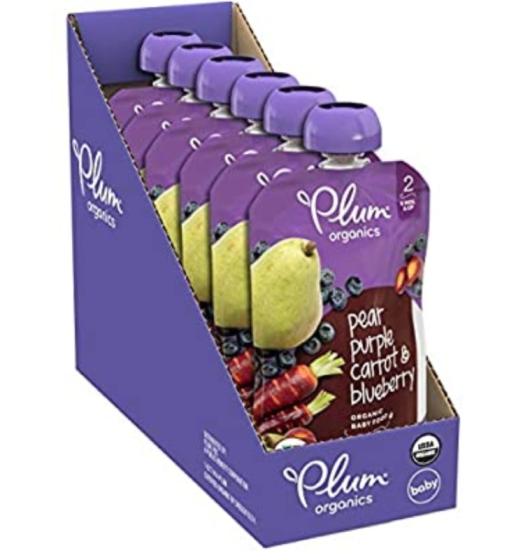 What is the packaging process like?
What is the packaging process like?


